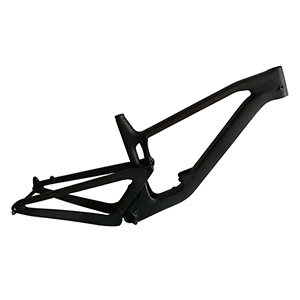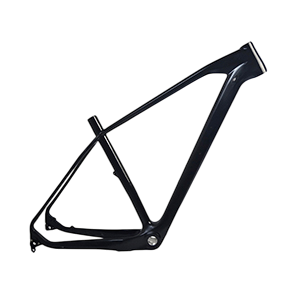
Full Suspension vs Hardtail: Which Mountain Bike Frame Is Right for You?
If you are buying a new mountain bike, you will inevitably face a major choice: full suspension or hardtail. You’re not just choosing a bike—you’re making a strategic decision for your brand, assembly plant, or bike shop. Full suspension mountain bikes have both front and rear shock absorbers, while hardtail bikes feature only a front shock absorber. The type of suspension affects the bike’s control, traction, and comfort, as well as the overall riding experience. Understanding these differences helps you select the right frames for your products or OEM projects, ensuring your inventory meets market demand and appeals to a wide range of riders.
Understanding Full Suspension MTB Frames
Full suspension MTB frames feature both front and rear shock absorbers, which help absorb impacts from rough and technical trails. You’ll notice improved traction, smoother control, and reduced rider fatigue, especially on challenging terrain. These frames are ideal for riders seeking comfort and performance in all conditions.
What Is the Difference Between Full Suspension and Hardtail Mountain Bikes?
When comparing full suspension and hardtail mountain bikes, the key differences lie in their frame design, ride comfort, and maintenance requirements.
Frame and Suspension Design
Full suspension bikes have both front and rear shock absorbers, which provide smoother rides over rough terrain and reduce rider fatigue. Hardtail bikes, on the other hand, have only a front suspension fork, offering lighter weight and more direct power transfer.
Performance and Handling
Hardtails excel on climbs and smooth trails because of their efficiency and responsiveness. Full suspension bikes shine on technical or uneven trails, improving traction and comfort.
Maintenance and Cost Considerations
Full suspension bikes typically require more maintenance and have higher production costs, while hardtails are simpler, more durable, and cost-effective. Balancing performance, cost, and maintenance will help you select frames that fit both your market strategy and production capabilities.
Carbon Frame vs Alloy Frame in Full-Suspension/Hardtail
Before diving into the differences between carbon frames and alloy frames, it’s important to understand how material choice affects performance, maintenance, and cost.
|
Feature |
Carbon Frame |
Alloy Frame |
|
Weight |
Lighter, helps improve climbing efficiency and acceleration |
Heavier, slightly reduces agility but still durable |
|
Strength & Durability |
High stiffness-to-weight ratio, strong but sensitive to impact |
Very durable and resistant to dents and scratches |
|
Ride Comfort |
Can be engineered for vibration damping, smoother ride |
Slightly harsher ride due to less vibration absorption |
|
Maintenance |
Requires careful handling and occasional inspection for cracks |
Easier to maintain, less prone to damage |
|
Cost |
Higher production cost, premium segment |
More cost-effective, suitable for bulk production |
|
Application |
Popular in full suspension high-performance bikes |
Common in hardtails and entry-to-mid-level bikes |
|
OEM Considerations |
Ideal for brands targeting high-end market and performance riders |
Suitable for brands looking for durability and cost-efficiency in inventory |
By understanding these trade-offs, you can select the right frames for your product lineup, balancing rider performance, production efficiency, and market demand. Offering a mix of hardtail and full suspension models ensures your inventory meets diverse customer needs.
Which Bike Is Right for Your Riders or Customers?
A Carbon Full Suspension Mountain Bike Frame Is Right for You If:
You are willing to spend a little more: High-quality entry-level full-suspension mountain bikes start at about $1,500. If you are willing to spend that amount (or more) and the full suspension makes sense for the type of terrain you want to ride, then this might be a good choice.
Your main technical route: If you think cycling in a rock garden, on tree roots, and downhill is a fun ride, then a full suspension mountain bike is your ideal choice. The combination of front and rear suspension creates a smoother ride and better traction and handling, which can be translated into more fun on rugged terrain.
You want a more comfortable riding experience: Full suspension mountain bikes can absorb most of the discordant bumps; otherwise, these bumps will be transmitted to your body (in some cases, you will get off the bike). This helps reduce fatigue, allowing you to ride faster, longer, and more comfortably.
You need speed: The front and rear suspension do a very good job of absorbing bumps, so you can usually get higher speeds than the technical section with a hardtail.


|
Feature |
Hardtail MTB Frame |
Full Suspension MTB Frame |
|
Maintenance |
Easier, fewer components to service |
More complex, requires regular inspection of rear suspension |
|
Durability |
Highly durable, less prone to damage |
Strong but more sensitive to impact and wear |
|
Lifecycle Cost |
Lower overall cost |
Higher initial cost and ongoing maintenance expenses |
|
Rider Experience |
Efficient and responsive on smooth trails |
Superior comfort and control on technical terrain |
Categories
New Blog
Copyright © 2025 Top-Fire Carbon Technology Co., Ltd. All Rights Reserved. Power by

IPv6 network supported